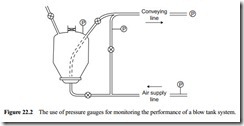Rotary valves
Rotary valves are probably the most commonly used device for feeding pipelines, particularly in low pressure conveying systems. They are available in a wide range of sizes and there are many different types for free flowing, granular and cohesive materials, as
considered in Section 3.2. The mechanism of feeding, however, gives rise to a number of problems, and in positive pressure systems allowance must be made for air leakage.
Flow control
It is essential that the pipeline should be fed at the correct rate. If the feed rate is too low the pipeline will be under-utilized, and if the feed rate is too high the pipeline could block. Flow control can be achieved by varying the rotational speed of the rotor. There is an upper limit for any given size of valve however, for the pocket filling efficiency will decrease with increase in speed. If a variable speed drive is provided the flow rate will be infinitely variable, as it is with a blow tank, up to its maximum capability with a material. If some form of gearing is provided only step changes will be possible.
Many rotary valves are dedicated to a single material and duty, and no means of speed control is incorporated. If a material is to be conveyed over a different distance, a corresponding change in feed rate will be required. If a different material is to be conveyed it is quite likely that both the pipeline and rotary valve feeding characteris- tics for the material will be different. As it is a volumetric feeder, those for the rotary valve will be particularly influenced by the bulk density of the material.
Air leakage
Air leakage across a rotary valve depends primarily upon the rotor tip clearance and the pressure drop across the valve. Air leakage also depends upon the material being fed. A cohesive material, for example, will help to seal the various clearances and so reduce the leakage rate. The influence of these parameters was illustrated with Figures 3.8 and 9. If air leaks across a rotary valve, less will be available to convey material through the pipeline. In specifying the air requirements for the air mover this must be taken into account. Air leakage will also increase with increase in size of the rotary valve. If a valve is used which is larger than that necessary for the required duty, the air leakage will be unnecessarily high as a result.
Venting
The air leaking across the valve may interfere with the feeding of material into the rotary valve, as it will have to flow in the opposite direction to the flow of material in order to exit from the system. This reverse flow of air may restrict the material flow and prevent the pockets from being fully filled. This air may also fluidize the material and lower its bulk density, which will also reduce the feed rate. In this case the problem may be alle- viated by venting. Some material is likely to be carried over with the vented air and so the vent line must be kept clear. The vent should preferably discharge into the feed hop- per above, where the air can be filtered. The vent line must not be allowed to become blocked and so it must be designed as a miniature pneumatic conveying system itself.
A sketch of a vented rotary valve is given in Figure 22.3. The vent should be pos- itioned on the side of the body such that there is always one rotor blade positioned between the material feed and the vent to prevent a direct flow of material from the hopper to the vent.
Valve seizure
Valve seizure could be caused by the trapping of granular materials or by some foreign body in the material. If hot material is conveyed seizure could be caused by differential expansion problems. Particular care should be taken on start up with a cold valve. Insulation and trace heating may be necessary to maintain blade tip clearances, for if clearances become too great in such transient situations the pipeline could block because of a loss of too much air. If bearings are not protected and maintained, dust ingress could cause serious problems. If a bearing ran hot before seizure it could provide the necessary source of ignition for an explosion in a dusty environment (see Chapter 26).
Valve wear
Rotary valves are not generally recommended for handling abrasive materials, although they can be manufactured with wear resistant materials. Apart from abrasive wear of the sliding surfaces, erosive wear will be severe as a result of the very high velocities achieved by the air leaking through the valve. Wear will result in an increase in rotor tip clearances and hence an increase in air leakage. This, in turn, will cause a loss of air to the conveying line, which could ultimately result in pipeline blockage. This point was discussed in Section 20.2.4 and with Figure 20.11.

